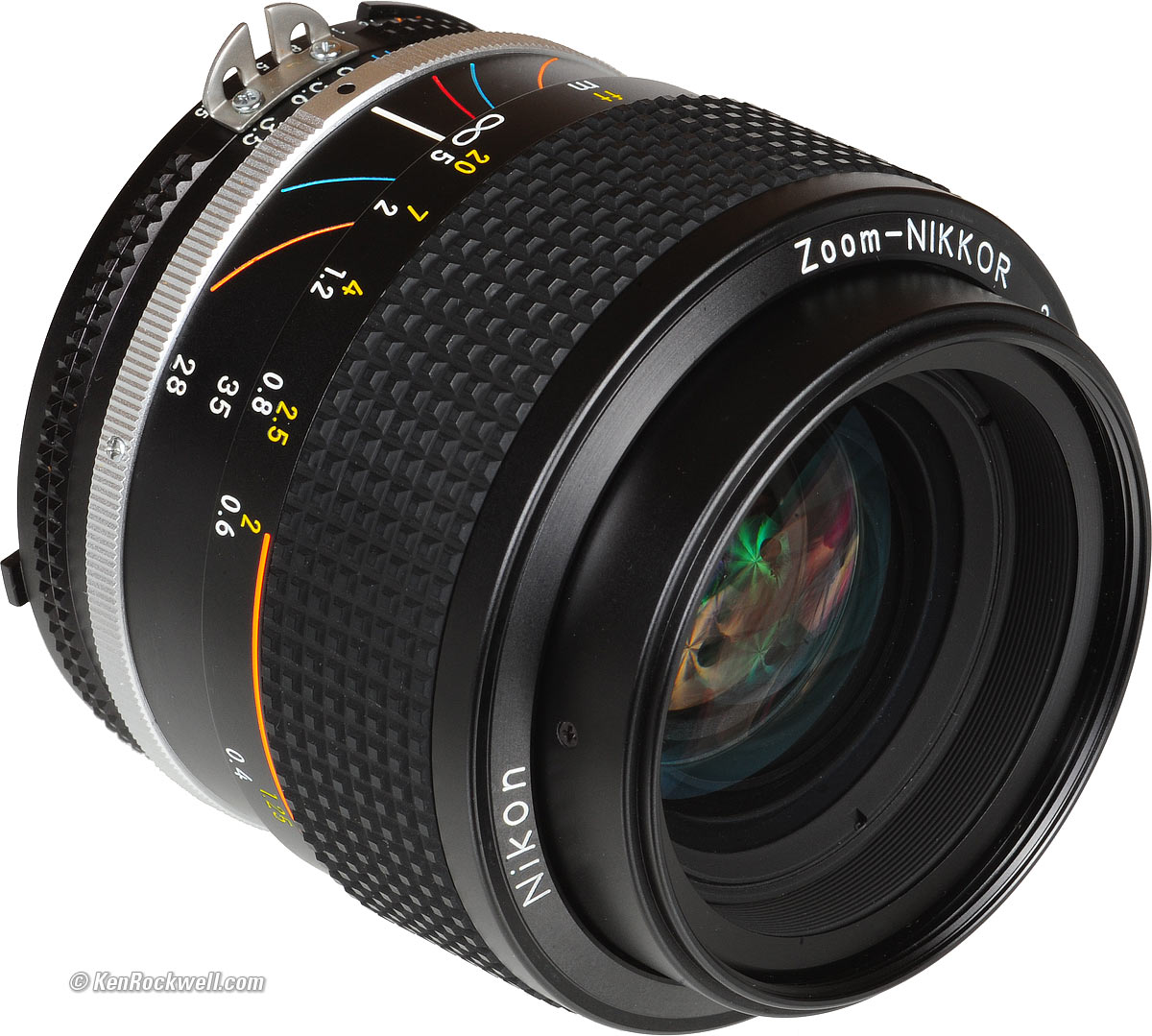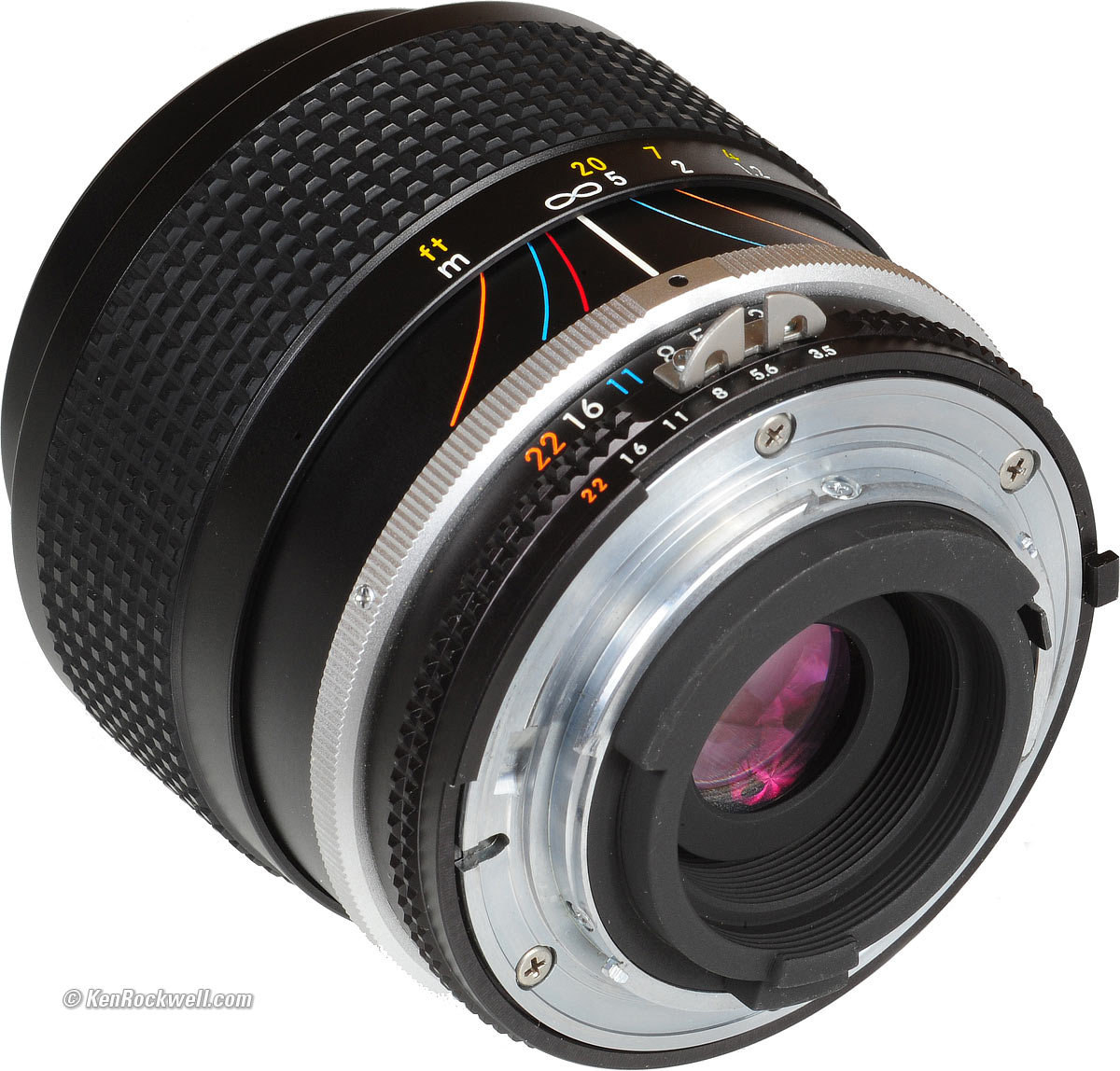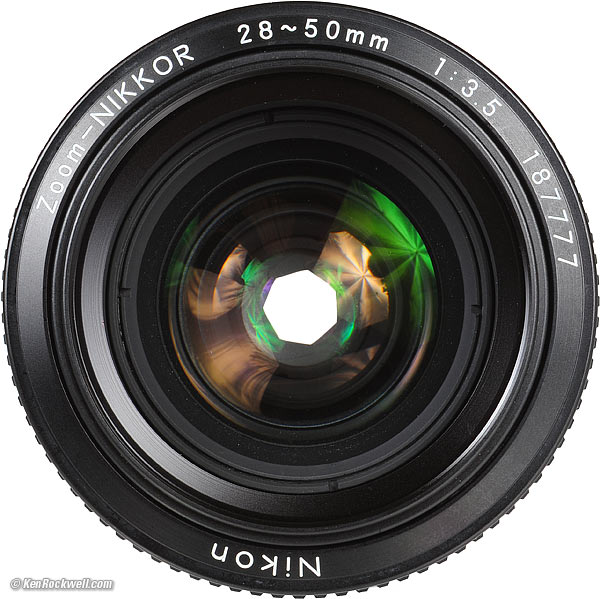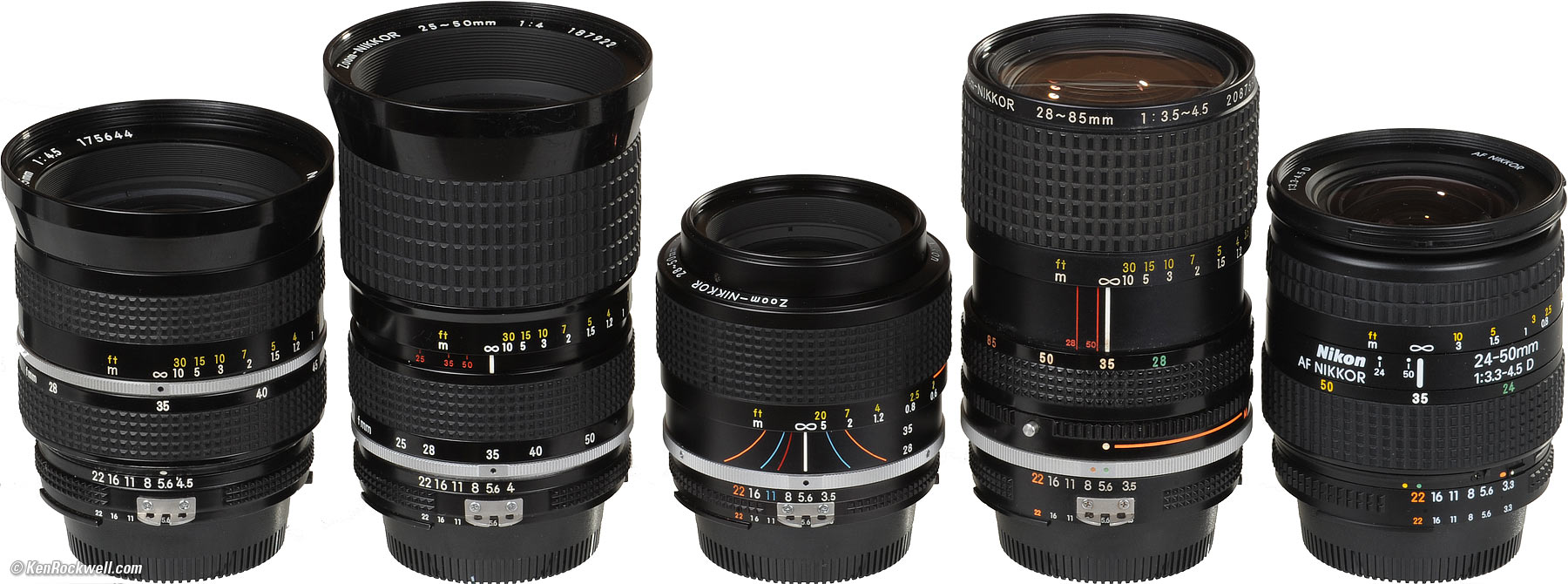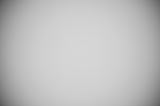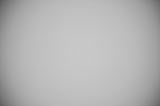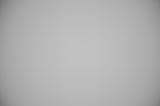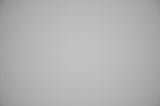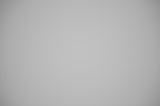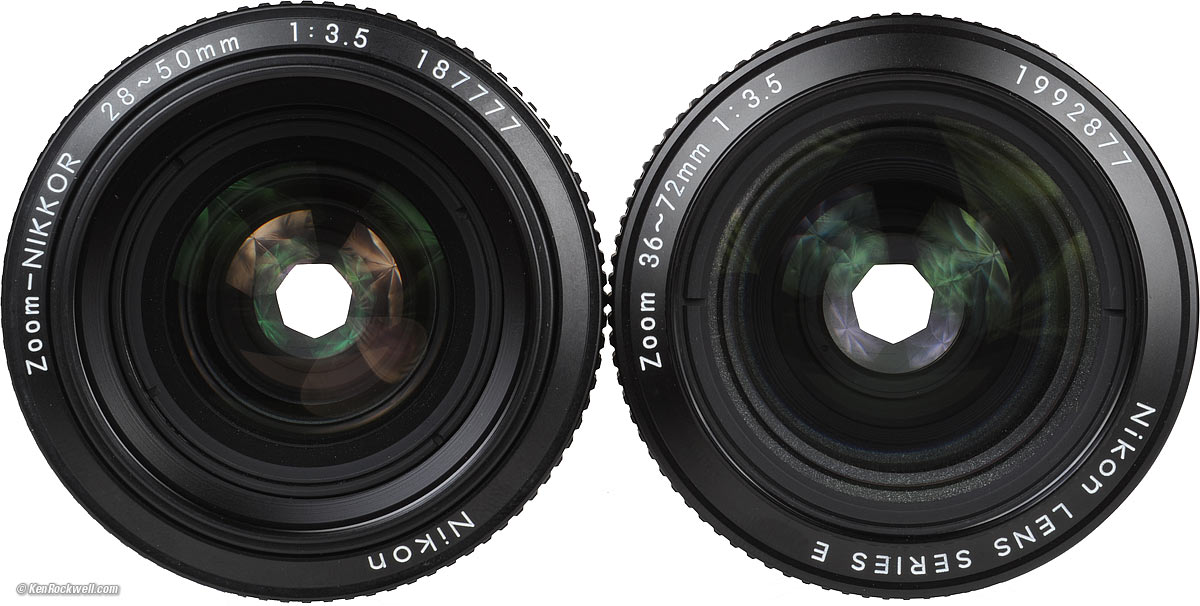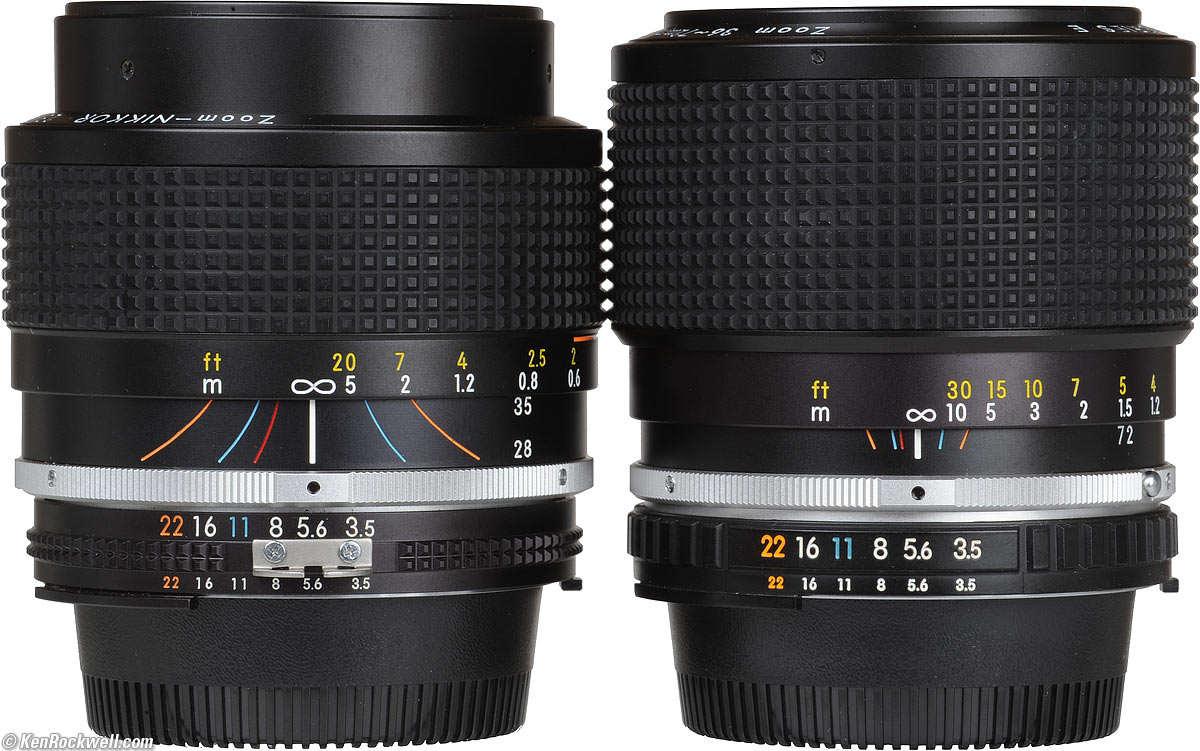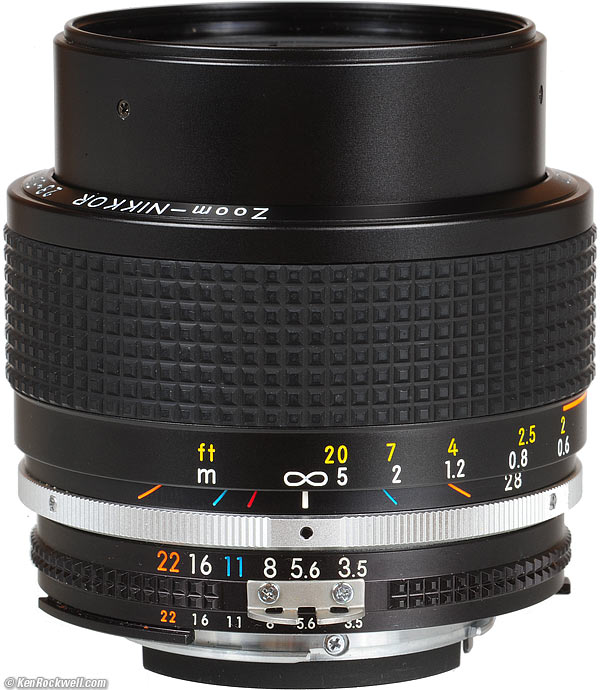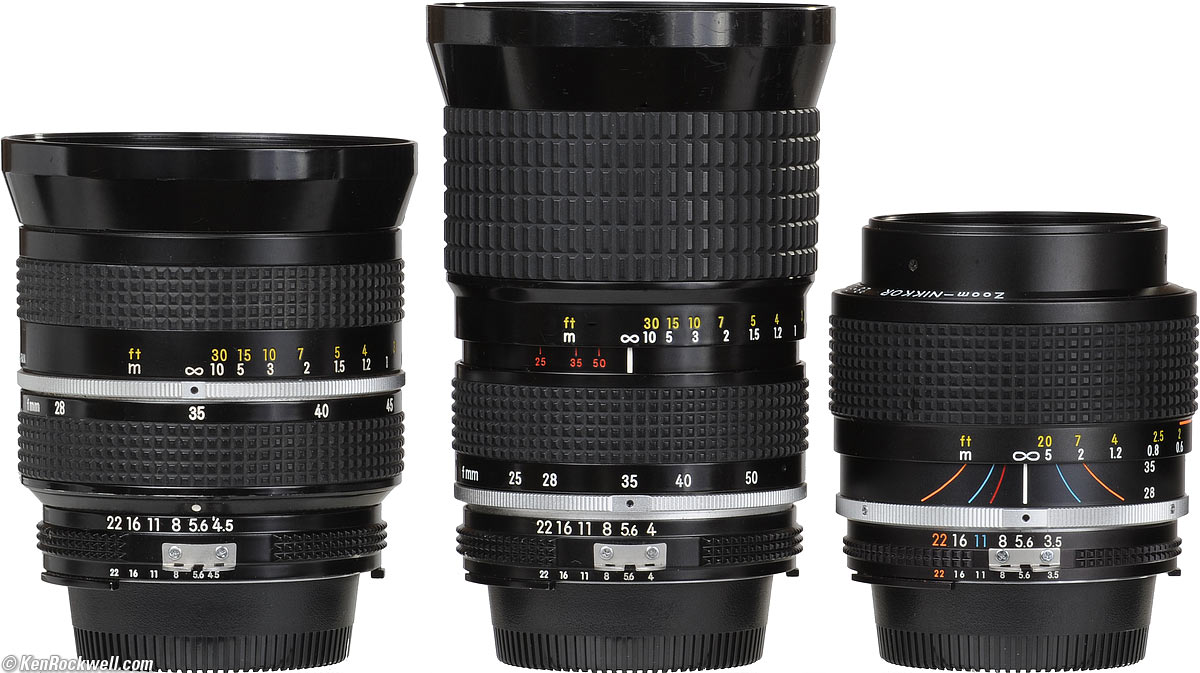Nikon 28-50mm f/3.5 AI-s
(1984-1987)
Intro Specifications Performance
Nikon 28-50mm f/3.5 AI-s (52mm filters,13.9 oz./395g, 2'/0.6m close focus, 0.20× macro ratio, about $100 used if you know How to Win at eBay). enlarge.
August 2023, July 2008 Better Pictures Nikon Nikon Lenses Nikon Flash All Reviews
| Optics: | |
| Ergonomics: | |
| Usefulness: | |
| Availability: | |
| Overall: |
Ideal Uses: FX and film cameras for travel or a general just-walking-around manual-focus wide-to-normal zoom.
Not For: It works on DX cameras, but why bother when even the 18-55mm kit lens is far handier?
Introduction top
Intro Specifications Performance
Compatibility History Production Pricing
The Nikon 28-50mm is Nikon's smallest f/3.5 constant aperture zoom. If you're in the mood to focus by hand, its a winner in every way. It's fast in both aperture and handling, and is small, very sharp and easy to use. It just goes.
It focuses to two feet (0.6m), and has an especially handy macro range to 1.1 feet (0.35m) at 50mm, right where you'd want a macro range. You don't need to fiddle with macro switches; it just focuses that close if you're zoomed to 50mm. Most other lenses stupidly give you the macro range at the wide end where you don't want it.
It is faster than almost every other amateur zoom. It has a constant aperture of f3.5, even at 50mm.
I got mine used at this link to it at eBay (How to Win at eBay).
Nikon 28-50 f/3.5 AI-s rear view. enlarge.
Compatibility back to intro back to top
The manual-focus 28-50mm f3.5 AI-s works great with most Nikon cameras, film and digital.
It works flawlessly with every manual focus Nikon ever made, from the F of 1959 through the FM3a and today's FM-10.
On the D3, D700, D300, D200, D2 and F6, use three settings in the "Non-CPU Lens Data" menu option to set 28mm and f/3.5, 35mm and f/3.5, and 50mm and f/3.5, to get full matrix metering, EXIF data and finder read-out of set aperture. I set my Function Button so I can flick among these three settings. The only reason to bother changing the setting is if you want the EXIF to have the exact focal length; if not, just set any of these so long as you have f/3.5. It works great in aperture-preferred as well as manual modes on these cameras.
The meters of cheaper digital (D80 and below) and cheaper film cameras (N80 and below) will not couple (or work at all) with this lens, so you'll be on your own guessing exposure using the rear LCD or an external meter.
It works perfectly every professional film camera (F, F2, F3, F4, F5, F6), and adds Matrix metering on the FA, F4 and F6.
See Nikon Lens Compatibility for details on your camera. Read down the "AI, AI-s" column for this lens.
Nikon 28-50mm f/3.5 AI-s set to 50mm and f/5.6.
History back to intro back to top
28-45mm f/4.5, 25-50mm AI, 28-50mm AI-s, 28-85mm AI-s and 24-50mm D.
enlarge.
1975-1978: Nikon's first wide-angle zoom was the 28-45mm f/4.5. It was slower, bigger and klunkier, and required two rings, one for zoom and the other for focus. It was sharper at the wide and not quite as good at the long end as this 28-50mm f/3.5. The 28-45mm lens started as a non-AI lens, and was updated to AI in the middle of its life.
1979-1985: Nikon's second wide zoom, the 25-50mm f/4 AI is a big, pro lens. It's also less easy to use than this 28-50mm because is has separate focus and zoom rings. It started as an AI lens, and was updated to AI-s in 1981.
1984-1985: This gem of a 28-50mm lens came out in the beginning of 1984, and was discontinued in late 1985. It's the smallest and fastest of any of these lenses. It was always an AI-s lens.
1985-2005: This 28-50mm is replaced by the 28-85mm f/3.5-4.5AI-s manual focus, which also became the AF 28-85 from 1990-1999. In 1986-87, the 28-50mm sold for $220, while the 28-85mm sold for $295-340 at full NYC discount..
1987-1995: Nikon made the so-so 24-50mm f/3.3-4.5 D AF.
Production back to intro back to top
Nikon made about 25,000 of these 28-50mm AI-s lenses, not bad for only a year or two of production.
Pricing back to intro back to top
When new, the 28-50mm was one of Nikon's least expensive zooms.
Although inexpensive among zooms, zooms were still more expensive than fixed lenses. This 28-50mm cost about the same as a nicer-than average fixed AI-s lens. In 1986, the 50/1.4 AI-s sold new for $134, the 24/2.8 AI-s for $189 and the 20/2.8 AI-s for $300, brand new at full NYC discount.
Price, new* |
Corrected for inflation, 2008 |
Corrected for inflation, 2023 |
|
1986 |
$217 |
$430 |
$601 |
1987 |
$229 |
$440 |
$612 |
Used |
$200-$400 used (2008) |
about $100 used if you know How to Win at eBay (2023) |
*at full NYC discount. Very few people bought their lenses this inexpensively back then.
Specifications top
Intro Specifications Performance
I got mine used at this link to it at eBay (How to Win at eBay).
Nikon 28-50mm f/3.5 Controls.
Optics
9 elements in 7 groups.
It's multicoated, which Nikon calls Nikon Integrated Coating.
Close Focus
2 feet (0.6m).
At 50mm only, close focus is 1.1 feet (0.35m).
Maximum Reproduction Ratio
1:5.1 (0.20×).
Hard Infinity Focus Stop?
Yes.
This is great for astronomy; just turn to the stop and you have fixed laboratory-perfect focus all night.
Depth-of-Field Scale
Yes, colored "firebird" for f/11 and f/22.
Infra-Red Focus Index
Yes, red line for every focal length on the barrel's "firebird" depth-of-field calculator.
Diaphragm
7 straight blades.
Stops down to f/22.
Aperture Ring
Yes.
Filter Thread
52mm, metal.
Rotates with focus but not with zoom.
Size
Nikon specifies 2.58" (65.5mm) extension from flange by 2.70" (68.5mm) diameter.
Length does not change with zooming and does extend as focused more closely.
Weight
Lens alone: 13.920 oz. (394.6g), actual meaured weight.
Nikon specifies 13.9 oz. (395g).
Hood
HK-12 metal slip-on with friction clutch.
Case
Optional CL- 34A, or pouch #62.
Teleconverters
TC-200/201 and TC-14A.
Performance top
Intro Specifications Performance
Overall Focus Bokeh Color Distortion Falloff Filters
Color Fringes Mechanics Sharpness Sunstars Zooming
I got mine used at this link to it at eBay (How to Win at eBay).
Overall back to Performance back to top
The 28-50mm f/3.5 AI-s is an easy lens to love. It's sharp, contrasty, small, light, and super-easy to use.
Focus back to Performance back to top
Manual focus is excellent. You can flick it with a fingertip.
It feels like a Series E zoom: there is a little play n the focus and zoom ring, unlike real Nikkors which have zero play.
It focuses perfectly at infinity at its infinity stop. It doesn't wander as many zooms do.
The 28-50mm is better than most zooms on a manual-focus camera like an FE because it has a faster f/stop. This leads to a brighter finder than an f/4.5 zoom, and also prevents central split-image rangefinder blackout without needing to keep your eye centered.
The D3, D700, F4, F6 and most professional AF cameras have three very precise electronic manual focus indicators.
Lesser digital cameras, like the D300 and down, usually have just one "OK" focus dot, which is not as precise as two arrows and a dot.
Bokeh back to Performance back to top
I don't see any particularly good or bad bokeh. This 28-50mm f/3.5 isn't long enough or fast enough to have much out of focus anyway.
Color Rendition back to Performance back to top
The few times I've shot this lens, conditions must have been right because everything just looks great. I seriously doubt that the 28-50mm lens renders more vivid colors than my other lenses, but its nice to imagine.
Distortion back to performance back to top
The 28-50mm has typical barrel (bulging) distortion at 28mm, and very little pincushion distortion at 50mm.
Plug these figures into Photoshop CS2's lens distortion filter to rectify this. These aren't facts or specifications, they are the results of my research that requires hours of photography and calculations on the resulting data.
FX and Film at infinity |
FX and Film |
FX and Film at 1.1' (0.35m) |
|
28mm |
+4.2 |
+2.5* |
n/a |
35mm |
+1.2 |
+0.5* |
n/a |
50mm |
-0.2 |
-1.0* |
0 |
© 2008 KenRockwell.com. All rights reserved.
*Some waviness remains.
Falloff (darkened corners) back to performance back to top
Falloff on FX is minor. With real photos, it might be a little visible (but not annoying) wide-open at 28mm, but goes away by stopping down to f/5.6 or by zooming to 35-50mm.
I doubt it would be visible at all on DX.
I've exaggerated this by shooting a gray field and placing these on a gray background.
Nikon 28-50mm f/3.5 AI-s falloff on film and FX at infinity. At 28mm
At 35mm
At 50 mm
|
Filters, Use with back to Performance back to top
There is no problem with vignetting at the longer settings, but at 28mm and closer focus distances you may want to be careful on FX and film with thick filters or combinations of filters.
The filter ring rotates with focus, but not with zoom.
Lateral Color Fringes back to Performance back to top
There are no lateral color fringes when used on the D3, which corrects them if they were there. With modern Nikon digital cameras, this is no longer an issue.
Mechanics back to Performance back to top
Nikkor 28-50mm and Series E 36-72mm. enlarge.
The Nikkor 28-50mm f/3.5 is really a Nikon Series E lens in disguise. Few people bought the Series E lenses (1979-1985) because Nikon was honest in admitting that although optically excellent., Nikon cut a few corners in their mechanics. The less expensive mechanics of the Series E lenses meant nothing to the amateurs for whom they were designed and priced, but Nikon's honesty scared people away. Not to be outwitted by its customers again, Nikon branded this 28-50mm lens as a NIKKOR.
Nikkor 28-50mm and Series E 36-72mm. enlarge.
This 28-50mm is swell, but on the flimsier side as were Nikon's other last-to-be-introduced AI-s lenses of the mid 1980s.
Barrel Exterior
Anodized aluminum, no enamel overcoat as tougher Nikkors.
Filter Threads
Anodized aluminum.
Focus Ring
Aluminum, rubber covered.
Focus Helicoids
Feel like aluminum: reasonably smooth, but with some play.
Depth-of-Field Calculator
Engraved into barrel and filled with different colors of paint.
Internals
All metal.
Aperture Ring
Billet aluminum, anodized but not enameled.
Engraved markings filled with different colors of paint coded to the depth-of-field scale.
Mount
Dull-chromed brass.
Markings
Engraved into the metal and filled with paint.
Identity and Serial Number
On front of lens outside filter ring, engraved into the metal and filled with paint.
Dust Seal at Mount
No.
Noises When Shaken
Mild clicking from the diaphragm blades and some clunking from the zoom optics.
Made in
Japan.
Sharpness back to Performance back to top
The 28-50mm is a sharp lens. Its performance is pretty much the same at all focal lengths.
Warning 1: Image sharpness depends more on you than your lens.
Warning 2: Lens sharpness doesn't mean much to good photographers.
At 28mm on 12 MP FX seen at 100% on-screen (40" or 1m wide prints):
At f/3.5: Sharp and contrasty all over, but softer in the last 5mm of the far corners.
At f/4: Sharp all over, just a tiny bit better than f/3.5 in the far corners.
At f/5.6: Far corners much better, still a bit soft.
At f/8: Sharp all over, the optimum aperture at 28mm.
At f/11: Farthest corners a tiny bit sharper, rest of frame just a tiny bit softer from diffraction.
At f/16: Softer from diffraction.
At f/22: Softer from diffraction.
At 35mm on 12 MP FX:
At f/3.5: Sharp and contrasty all over, but softer in the last 5mm of the far corners.
At f/4: Sharp all over, just a tiny bit better than f/3.5 in the far corners.
At f/5.6: Far corners much better, almost perfect.
At f/8: Sharp all over, the optimum aperture at 35mm.
At f/11: Same as f/8. Farthest corners just a tiny, tiny bit sharper, while the other 95% of the frame is just a bit softer from diffraction.
At f/16: Softer from diffraction.
At f/22: Softer from diffraction.
At 50mm on 12 MP FX:
At f/3.5: Contrasty all over, but not as sharp.
At f/4: Just a tiny bit better than f/3.5.
At f/5.6: Sharp and contrasty all over, last few millimeters of the farthest corners a bit softer.
At f/8: A tiny bit sharper than f/5.6. f/8 is the optimum aperture at 50mm.
At f/11: Same as f/8. Farthest corners a tiny bit sharper, while the other 95% of the frame is just a little bit softer from diffraction.
At f/16: Softer from diffraction.
At f/22: Softer from diffraction.
Sunstars back to Performance back to top
With its straight 7-bladed diaphragm, the 28-50mm makes Nikon's standard 14 -pointed sunstars on bright points of light.
Zooming back to Performance back to top
Roll mouse over to zoom from 28mm to 50mm!
The 28-50mm is a push-pull zoom. One ring controls both focus and zoom.
The zoom ring moves up and down, but the len's barrel doesn't move.
It's easy to zoom, but takes two fingers.
Zooming is more damped than focus, so it's easy to zoom with two fingers, then shoot with one hand using just a fingertip for focus.
Compared top
Intro Specifications Performance
I got mine used at this link to it at eBay (How to Win at eBay).
Nikon 28-45mm f/4.5, 25-50mm f/4 AI and 28-50mm f/3.5 AI-s. enlarge.
I compared the 28-50mm to the Nikon 28-45mm f/4.5 AI and 25-50mm f/4 AI.
This 28-50mm is the smallest, lightest and newest of these three. It's also the fastest, at f/3.5, and dinkiest, being made more to Series E standards than Nikkor.
All three focus to 2 feet (0.6m), but this 28-50mm adds a seamless macro range to 1.1 feet (0.35m) at 50mm.
I prefer the single zoom and focus ring of the 28-50mm over the slower and clumsier two-ring systems of the others. Your taste will vary.
The other zooms take 72mm filters, this 28-50mm takes 52mm filters.
Compared to the earliest 28-45mm at 28mm, this 28-50mm is softer in the corners wide-open, and the same stopped-down. At 50mm, I prefer this 28-50mm to the older 28-45mm.
This 28-50mm is about the same as the 25-50mm f/4 AI.
Recommendations top
Intro Specifications Performance
I got mine used at this link to it at eBay (How to Win at eBay).
What's not to like for film and FX? If you come across one of these and want a fast, small, fun, sharp and practical manual-focus zoom, this 28-50mm f/3.5 AI-s is a winner.
© Ken Rockwell. All rights reserved. Tous droits réservés. Alle Rechte vorbehalten. Alla rättigheter förbehållna. Toate drepturile rezervate. Ken Rockwell® is a registered trademark.
Help Me Help You top
I support my growing family through this website, as crazy as it might seem.
The biggest help is when you use any of these links when you get anything. It costs you nothing, and is this site's, and thus my family's, biggest source of support. These places always have the best prices and service, which is why I've used them since before this website existed. I recommend them all personally.
If you find this page as helpful as a book you might have had to buy or a workshop you may have had to take, feel free to help me continue helping everyone.
If you've gotten your gear through one of my links or helped otherwise, you're family. It's great people like you who allow me to keep adding to this site full-time. Thanks!
If you haven't helped yet, please do, and consider helping me with a gift of $5.00.
As this page is copyrighted and formally registered, it is unlawful to make copies, especially in the form of printouts for personal use. If you wish to make a printout for personal use, you are granted one-time permission only if you PayPal me $5.00 per printout or part thereof. Thank you!
Thanks for reading!
Ken.
